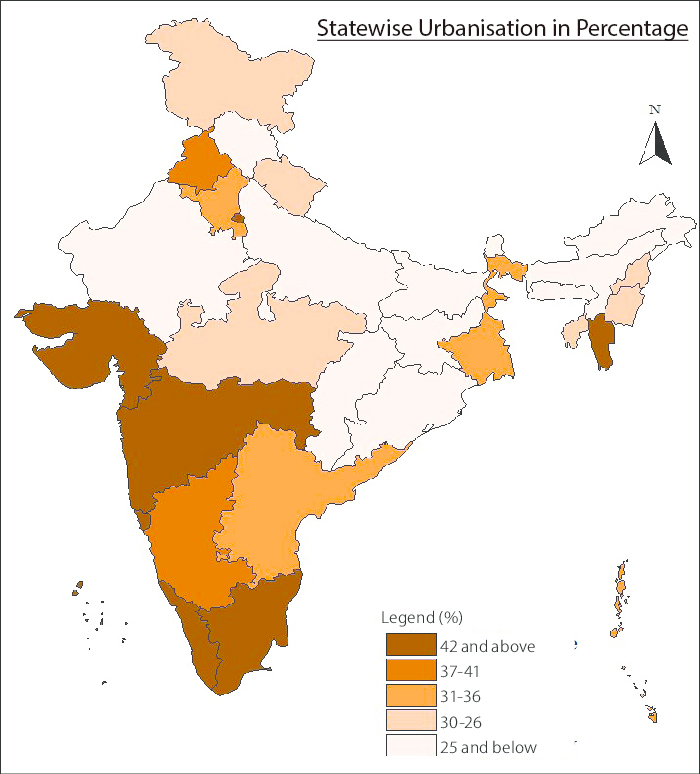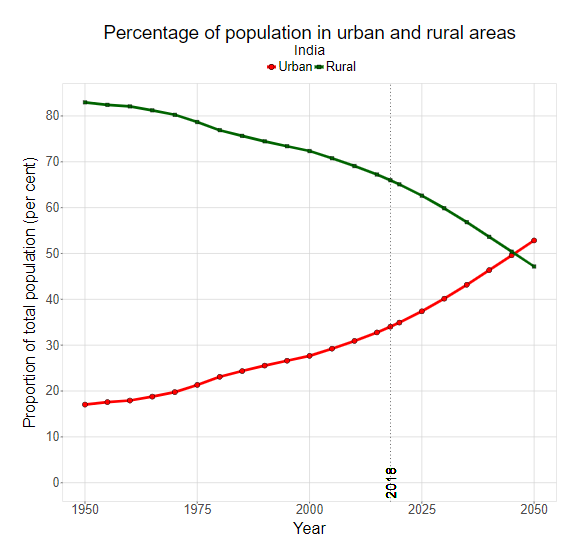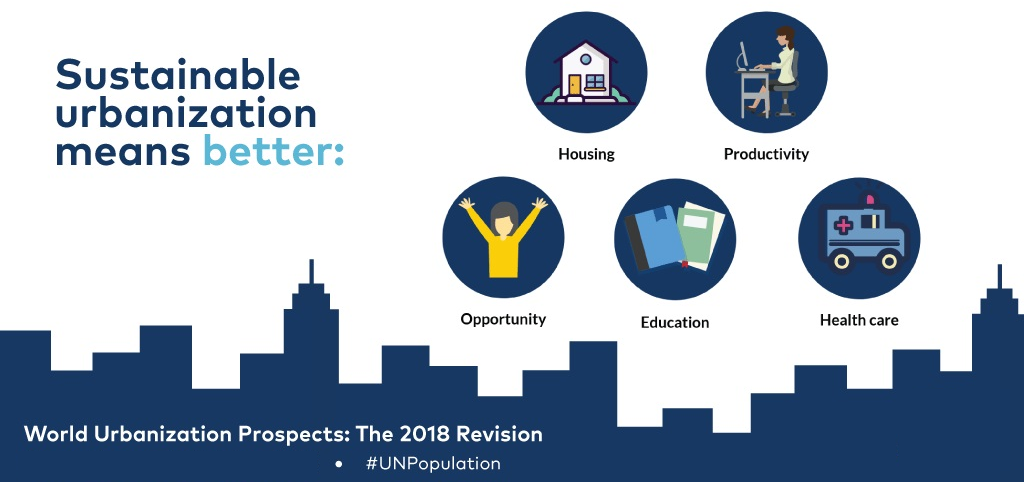Governance
Revitalizing Urban Development: Kerala Initiative
This editorial is based on “Breaking new ground the Kerala way” which was published in The Hindu on 05/01/2024. The article discusses the different urbanisation aspects in India and how the Kerala Urban Commission can lead the way for the rest of India in understanding urbanisation as a whole process.
For Prelims: Smart Cities, AMRUT Mission, Swachh Bharat Mission-Urban, HRIDAY, Pradhan Mantri Awas Yojana-Urban, Aspirational district programm, Wastewater treatment plan, Geographic information systems (GIS)
For Mains: Major Challenges Related to India’s Urban Space and the Reforms Required, Recent Initiatives Related to Urban Development.
India, among the world's fastest-growing economies, is predominantly driven by its cities, projected to contribute 70% to the country's GDP by 2030. The World Bank estimates a crucial investment of USD 840 billion over the next 15 years to meet the demands of the rapidly expanding urban population. This rapid urbanization, while promising economic prosperity, brings forth challenges to liveability. A closer examination uncovers inherent limitations within the existing framework of urbanization, emphasizing the need for strategic solutions to ensure sustainable growth. The recently constituted Kerala Urban Commission is slated to reform the urban landscape in the state.
What is Kerala Urban Commission?
- Historic Developments:
- The announcement of the Kerala Urban Commission in 2024 marks a significant development after a hiatus of 38 years since the National Commission on Urbanisation led by Charles Correa.
- The first commission, initiated by Prime Minister Rajiv Gandhi, faced interruptions due to his assassination, but it laid the groundwork for subsequent urban policies.
- Formation of Kerala Urban Commission:
- The formation of the Kerala Urban Commission with a 12-month mandate aims to address the specific challenges of Kerala's urbanization.
- With an estimated 90% urbanized population, the commission seeks to create a roadmap for the state's urban development over the next 25 years.
- Role of Kerala Urban Commission:
- The Kerala Urban Commission, despite not being a national commission, serves as a potential lighthouse for other highly urbanized states like Gujarat, Maharashtra, Tamil Nadu, and Punjab.
- It offers a learning opportunity for states grappling with high urban populations, showcasing a comprehensive approach to urban challenges.
- Contemporary Relevance of Kerala Urban Commission:
- Given the complexity of urbanization patterns, an urban commission is deemed necessary at national and state levels.
- Piecemeal approaches like Swachh Bharat Mission or AMRUT have failed to address the multifaceted challenges.
- An urban commission understands migration, settlement patterns, and the role of information technology in the context of evolving urban realities.
What Led to the Development of Kerala Urban Commission?
- Urbanization Challenges Worldwide:
- The global urban population has surged to 56%, compared to just over 5% during 1860s. Urbanization, with its far-reaching impacts on climate, land use, and inequality, has become a pivotal aspect of capital accumulation.
- Cities have witnessed spatial and temporal changes, posing challenges in various areas such as pollution, housing, and sanitation.
- Shifts in Urban Development Paradigms:
- Post-independence, India experienced two distinct phases of urban development:
- First Phase:
- The Nehruvian era, spanning nearly three decades, emphasized centralized planning and master plans, pushing rural-to-urban migration driven by manufacturing.
- However, this approach faltered, leading to the subsequent privatization of cities in the 1990s, with a focus on global city models and project-oriented development.
- The Nehruvian era, spanning nearly three decades, emphasized centralized planning and master plans, pushing rural-to-urban migration driven by manufacturing.
- Second Phase:
- The 1990s witnessed the privatization of cities with master plans entrusted to large parastatals and consultancy firms.
- Social housing, public health, and education gave way to real estate-centric models, promoting cities as 'engines of growth' rather than spaces of enlightenment.
- This era marked a departure from holistic city approaches to project-oriented developments.
- First Phase:
- Post-independence, India experienced two distinct phases of urban development:
- Governance Challenges in Cities:
- City governance faces challenges, with subjects under the 12th Schedule not yet transferred to cities. There's a debate about having managers rather than elected officials running city affairs.
- The Fifteenth Finance Commission's centralization in financial architecture ties grants to property tax collection performance, adding complexity to urban governance.
- Necessity for Holistic Understanding:
- The urban commission must move beyond piecemeal approaches and delve into a holistic understanding of urbanization, encompassing migration, settlement patterns, and the role of information technology.
- Approaches like SMART CITIES have fallen short of addressing objective realities, emphasizing the need for a more comprehensive strategy.
What are the Challenges Related to India’s Urbanisation?
- Private Transport and Urban Challenges:
- The preference for private transport based on social status has led to road overcrowding, increased pollution, and extended travel times in cities.
- This dependency on cars is a significant contributor to climate change due to the prevalent use of combustible fuel, emphasizing the urgent need for sustainable transportation solutions.
- Growth of Slums and Urban Migration:
- The high cost of living in urban areas, coupled with the influx of rural migrants, has led to the growth of slums as makeshift shelters.
- The World Bank reports that 35.2% of India's total urban population resides in slums, with Dharavi in Mumbai being recognized as the largest slum in Asia.
- Environmental Impact of Urbanization:
- Urbanization is a major cause of environmental degradation, with increased population density affecting air and water quality.
- Deforestation and land degradation for construction, improper waste disposal, and inefficient sewage facilities contribute to pollution, impacting the overall environmental health of cities.
- Urban Heat Island Effect:
- Urban areas, characterized by dense structures, pavements, and limited green spaces, experience the Urban Heat Island effect.
- This phenomenon raises energy costs, worsens air pollution, and contributes to heat-related illnesses and mortality.
- New developments encroaching on natural water bodies further disrupt the urban ecosystem.
- Flooding and Infrastructure Challenges:
- Rapid urbanization, coupled with limited land availability, results in developments encroaching on lakes, wetlands, and rivers.
- This disrupts natural drainage systems, leading to urban flooding.
- Inadequate solid waste management exacerbates flooding issues, emphasizing the need for comprehensive urban planning and infrastructure development.
- Challenges Faced by Urban Local Bodies (ULBs):
- Despite the broad functions outlined for Urban Local Bodies (ULBs) by the Constitution, the lack of a time-bound audit and an imbalance in powers, responsibilities, and funds from the Centre and State hinder their effective functioning.
- This underscores the necessity for reforms to empower ULBs and enhance their capacity to address urban challenges.
What are the Related Initiatives?
What are the Steps Required for Urban Reforms in India?
Along the lines of Kerala Urban Commission, a new India Urban Commission need to be set up that will promote the implementation of following suggestions for a sustainable urban landscape:
- Green Infrastructure and Innovative City Management:
- Efficient solutions for urban issues demand a shift towards green infrastructure, mixed-use of public spaces, and the adoption of alternative energy sources like solar and wind.
- Innovative ideas for affordable and effective city management, including public-private partnerships, are crucial for shaping healthier and more efficient urban spaces.
- Social Welfare in Urban Planning:
- Organized urban planning plays a pivotal role in improving the welfare of people. Transforming urban areas and neighborhoods into healthier, more efficient spaces requires a comprehensive approach that integrates social considerations.
- Schemes like the Indira Gandhi Urban Employment Guarantee Scheme in Rajasthan aim to provide basic living standards to the urban poor, addressing crucial social aspects of city development.
- Revamping Public Transport for Green Mobility:
- To achieve green mobility in India's urban landscape, a fundamental rethinking and rebuilding of public transport are essential.
- This includes introducing e-buses, creating dedicated bus corridors, and implementing bus rapid transit systems.
- These measures contribute to sustainable urban development with a focus on ecological and social considerations.
- Citizen Participation in Sustainable Development:
- The prevailing economic view of city development needs to give way to a sustainable perspective, incorporating ecological and social considerations.
- To democratize sustainable development at the local level, citizens should actively participate in governance through initiatives like participative budgeting.
- Locally appropriate tools and addressing urgent issues become central to this citizen-driven approach.
- Mandatory Sustainability Impact Assessments (SIA):
- Ensuring the integration of sustainability at the local level requires mandatory Sustainability Impact Assessments (SIA) related to any developmental activity.
- This strategic evaluation tool ensures that ecological and social considerations are systematically incorporated into urban development decisions, fostering a holistic and sustainable approach.
Conclusion
The trajectory of urbanization in India necessitates comprehensive urban reforms. Striking a balance between rapid development and sustainable practices is imperative. Urban reforms should prioritize social welfare, green infrastructure, citizen participation, and innovative governance to create cities that are not only hubs of economic growth but also exemplars of inclusivity and environmental responsibility. The ongoing transformation presents an opportunity for India to shape its urban landscape judiciously, fostering resilient and equitable cities for the future.
|
Drishti Mains Question: Discuss the challenges and solutions of urbanization in India, emphasizing sustainable development, social welfare, and effective governance. |
UPSC Civil Services Examination Previous Year’s Question (PYQs)
Prelims:
Q. With reference to the Indian economy after the 1991 economic liberalization, consider the following statements: (2020)
- Worker productivity (Rs. per worker at 2004-05 prices) increased in urban areas while it decreased in rural areas.
- The percentage share of rural areas in the workforce steadily increased.
- In rural areas, the growth in non-farm economy increased.
- The growth rate in rural employment decreased.
Which of the statements given above is/are correct?
(a) 1 and 2 only
(b) 3 and 4 only
(c) 3 only
(d) 1, 2 and 4 only
Ans: (b)
Mains:
Q. The frequency of urban floods due to high intensity rainfall isincreasing overthe years. Discussing the reasons for urban floods, highlight the mechanisms for preparedness to reduce the risk during such events. (2016)
Q. Do government’s schemes for up-lifting vulnerable and backward communities by protecting required social resources for them, lead to their exclusion in establishing businesses in urban economies? (2014)







